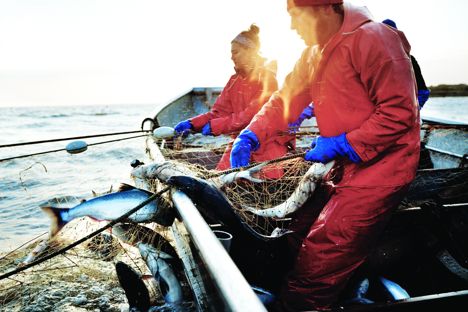
A prize catch: what makes Alaskan seafood great
We take a look at why Alaska is regarded as home to the best seafood – especially salmon – in the world, and how versatile the fish can be when cooking at home.
A prize catch: what makes Alaskan seafood great
We take a look at why Alaska is regarded as home to the best seafood – especially salmon – in the world, and how versatile the fish can be when cooking at home.
The pure, clear, cold and clean Pacific waters which surround Alaska are brimming with healthy, flavourful fish. Five species of wild Alaska salmon, several species of white fish and huge crabs and scallops mean fishing is big business in America’s 49th state, although the region’s fishermen know how important it is to keep the industry sustainable, preserving Alaskan seafood for generations to come.
Alaska is famous for all the fish and shellfish in its pristine waters, but the one that really stands out from the crowd is its wild salmon. The five species – king, sockeye, coho, keta and pink – are enjoyed the world over, famous for their rich, vibrant colour (which can vary from dark red to pastel pink) and succulent, delicate taste. It also has a firm texture and is low in fat thanks to its rich, varied diet. Wild Alaskan salmon is also incredibly healthy; it’s packed with protein, vitamins and minerals, as well as those all-important Omega 3 oils, which can help lower blood pressure.
Another reason why Alaskan salmon is so popular is how simple and quick it is to cook. The high amount of Omega 3 fatty acids means it’s especially speedy to cook – the average fillet can be pan fried to perfection in under ten minutes – and the fish is so incredibly versatile that it can take centre stage in everything from a canapé to a main course. You could even try hot-smoking the fillets yourself to create Mark Dodson’s Hot-smoked Alaska salmon with crab and aioli; something which would certainly cause a stir when served as a starter. Simply steaming, roasting, frying, grilling or poaching Alaskan salmon fillets and serving them whole alongside a few vegetables makes for a quick and healthy meal, but try flaking the flesh into a risotto, lightly curing a fillet to make gravadlax, adding it to a terrine or wrapping salmon up in a tortilla with coleslaw and coriander for a classic Alaskan fish taco. Keep an eye out in Waitrose stores from 16 December – the supermarket will be stocking Alaskan king salmon – regarded as the best of all the five species – for just a few weeks until mid-January. It’s perfect for a special dinner in the run-up to Christmas or as a healthy, delicious option after the new year begins.
Of course, if you know your way around a fillet and are more than comfortable cooking fish, then the other varieties of Alaskan seafood – particularly halibut, black cod and crab – will be sure to impress guests. These fish and shellfish live in the same pristine waters as salmon and are just as sought-after by home cooks and chefs alike thanks to their superior flavour and texture.
Eat ethically
You’d think having access to some of the best seafood in the world would make Alaska a haven for mass-fishing at unsustainable levels. However, when the region became a state in 1959, it was written into its constitution that fish ‘be utilised, developed and maintained on the sustained yield principle’. This made Alaska home to some of the most responsible and eco-friendly fisheries in the world, protecting wildlife in over one million square miles of its waters.
For the fishermen and women who spend their lives at sea catching Alaskan seafood, it’s much more than a job; it’s a way of life. They work closely with the state’s scientists to make sure everything they’re doing is sustainable, and that the fish they’re bringing to shore is of the very highest quality. It’s illegal to farm salmon in Alaska, so you know you’re buying a wild fish that’s been caught using ethical means, without all the waste and chemicals that can result from fish farms elsewhere in the world. So if you’re stuck for canapé ideas, are looking for a healthy alternative to meat or just simply love salmon, try Alaskan; it really is a cut above.


